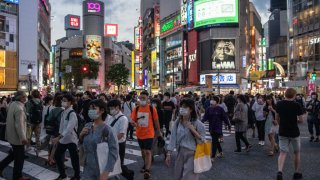
- Japan's core consumer prices may be approaching the central bank's 2% target, but veteran entrepreneur Ernie Higa says it's not time to cheer yet.
- The core consumer price index in Tokyo, which excludes fresh food and energy, rose 1.9% in May compared to the previous year, government data showed Friday.
- Japan is currently facing cost-push inflation where prices are going up while wages are not following, leaving retailers in a "difficult situation," Higa told CNBC's "Squawk Box Asia" on Friday.
Japan's core consumer prices may be approaching the central bank's 2% target, but veteran entrepreneur Ernie Higa says it's not time to cheer yet.
"When you talk about inflation, it's kind of like cholesterol – there's good cholesterol and bad cholesterol – what we're experiencing now in Japan is bad inflation," Higa, chairman & CEO at Higa Industries, who is known for bringing the Domino's Pizza franchise to Japan, told CNBC's "Squawk Box Asia" on Friday.
Get Boston local news, weather forecasts, lifestyle and entertainment stories to your inbox. Sign up for NBC Boston’s newsletters.
The core consumer price index in Tokyo, which excludes fresh food and energy, rose 1.9% in May compared to the previous year, government data showed Friday.
While that figure is just shy of the Bank of Japan's ever elusive inflation target, the rise in costs has been largely due to food and energy prices. Excluding fresh food and energy prices, the consumer price index in Tokyo rose just 0.9% year-on-year in May.
When the Bank of Japan announced its 2% inflation target, it was looking at demand-pull inflation where the rise in wages would create a "virtuous cycle" of consumer spending that further pushes prices and salaries up, Higa explained.
Money Report
But right now, the country is facing a cost-push inflation — where prices are going up while wages are not following, he added. "As a retailer you're really squeezed because all of your costs have gone up but you're not able to really pass on that cost … to the consumer."
To be clear, Japan is not the only major economy facing price pressures. Other countries like the U.S. and UK are currently facing arguably more severe cost of living problems.
The difference, however, is that the Bank of Japan continues to adopt an ultra-dovish monetary policy stance — keeping interest rates relatively low, at a time when peers at the U.S. Federal Reserve and Bank of England have been hiking rates to fight inflation.
The divergence in policy outlook has contributed to a sharp weakening in the Japanese yen so far this year, with the currency at one point weakening past the 130 handle against the greenback.
The yen has since strengthened from those levels, last trading at close to 127 per dollar as of Friday afternoon in Asia. But that's still a stark contrast to levels around 114 seen against the greenback earlier this year.
"The yen exchange is very important because Japan imports 60% of its food, not to mention 99% of its energy, and so this is causing a huge issue," Higa said. The Japanese currency's sharp weakening against the dollar is resulting in an "extreme cost," he added.
"If you import food, you can't even fix your cost, much less then how do you figure out … your selling price," he said.






